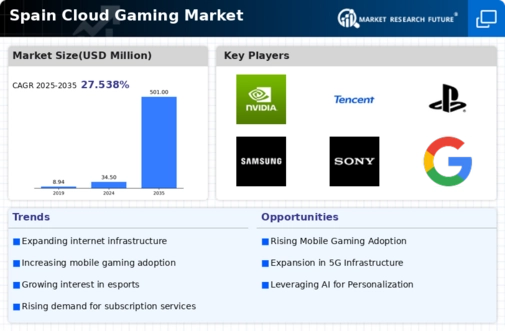The cloud gaming market in Spain is currently characterized by a dynamic competitive landscape, driven by rapid technological advancements and increasing consumer demand for seamless gaming experiences. Major players such as NVIDIA (US), Microsoft (US), and Sony (JP) are at the forefront, each adopting distinct strategies to enhance their market presence. NVIDIA (US) focuses on leveraging its powerful graphics processing units (GPUs) to deliver high-quality gaming experiences, while Microsoft (US) emphasizes its Xbox Cloud Gaming service, integrating it with its extensive gaming ecosystem. Sony (JP), on the other hand, is enhancing its PlayStation Now service, aiming to attract a broader audience through exclusive game offerings and strategic partnerships. Collectively, these strategies contribute to a competitive environment that is increasingly centered around innovation and user engagement.
In terms of business tactics, companies are increasingly localizing their services to cater to regional preferences, optimizing their supply chains to ensure efficient delivery of gaming content. The market structure appears moderately fragmented, with several key players vying for dominance. This fragmentation allows for diverse offerings, yet the influence of major companies remains substantial, shaping consumer expectations and industry standards.
In October 2025, Microsoft (US) announced a significant expansion of its Xbox Cloud Gaming service into Spain, aiming to enhance accessibility and user experience. This move is strategically important as it not only increases Microsoft's footprint in the region but also positions the company to better compete against local and international rivals. By expanding its service offerings, Microsoft (US) is likely to attract a larger user base, thereby solidifying its market position.
In September 2025, Sony (JP) launched a new initiative to integrate virtual reality (VR) capabilities into its cloud gaming platform. This strategic action is noteworthy as it reflects Sony's commitment to innovation and enhancing user engagement through immersive experiences. By incorporating VR, Sony (JP) aims to differentiate its offerings, potentially attracting gamers seeking cutting-edge technology and unique gameplay experiences.
In November 2025, NVIDIA (US) unveiled a partnership with a leading telecommunications provider in Spain to enhance cloud gaming performance through improved network infrastructure. This collaboration is crucial as it addresses latency issues, a common concern in cloud gaming, thereby improving the overall user experience. Such partnerships indicate a trend towards collaboration between tech companies and telecom providers, which may become a defining characteristic of the market.
As of November 2025, current trends in the cloud gaming market include a strong emphasis on digitalization, sustainability, and the integration of artificial intelligence (AI) into gaming experiences. Strategic alliances are increasingly shaping the competitive landscape, allowing companies to pool resources and expertise. Looking ahead, competitive differentiation is likely to evolve, with a shift from price-based competition to a focus on innovation, technological advancements, and supply chain reliability. This evolution suggests that companies will need to continuously adapt and innovate to maintain their competitive edge in an ever-evolving market.


















Leave a Comment